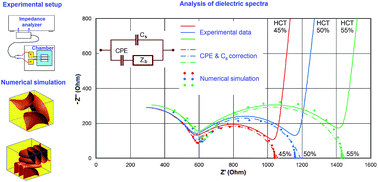当前位置:
X-MOL 学术
›
Anal. Methods
›
论文详情
Our official English website, www.x-mol.net, welcomes your feedback! (Note: you will need to create a separate account there.)
Electrochemical impedance spectroscopy of blood. Part 2: numerical analysis of experimental dielectric spectra using the biconcave shape of human erythrocytes
Analytical Methods ( IF 3.1 ) Pub Date : 2017-09-21 00:00:00 , DOI: 10.1039/c7ay01692a A. Zhbanov 1, 2, 3, 4 , S. Yang 1, 2, 3, 4, 5
Analytical Methods ( IF 3.1 ) Pub Date : 2017-09-21 00:00:00 , DOI: 10.1039/c7ay01692a A. Zhbanov 1, 2, 3, 4 , S. Yang 1, 2, 3, 4, 5
Affiliation

|
Results reported in the companion paper (Zhbanov and Yang, Anal. Methods, 2017, 17, 3302) showed that electrochemical impedance spectroscopy is a highly promising tool for the analysis of blood. In this study, dielectric spectra of human blood at various hematocrits were measured by using a two-electrode system in the frequency range from 40 Hz to 110 MHz. A numerical technique based on a finite difference method has been improved to calculate the effective complex permittivity of blood. Various models of erythrocyte shapes such as spherical, cylindrical, disk-shaped, spheroidal, and biconcave shapes were investigated. The numerical calculations showed that the cylindrical, disk-shaped, and biconcave models give comparable results, which differ significantly from those of the other models. Additionally, the effective complex permittivity of blood was analytically calculated based on the effective medium theory where erythrocytes are modeled as a conducting spheroid surrounded by a thin insulating membrane. The analytical calculation qualitatively reproduces the behavior of the dielectric spectrum, but quantitatively differs from the numerical simulation. The dielectric properties of erythrocyte cytoplasm and membranes were numerically determined based on the experimental data. Numerical analysis of the dielectric spectra of blood samples confirmed β-relaxation at frequencies between 100 kHz and 10 MHz and δ-relaxation in the frequency domain from 10 MHz to 1 GHz. The time-dependent changes in blood conductivity were measured during erythrocyte sedimentation. The measured blood conductivity increased slightly during the first minute and decreased within a few hours. This increase is attributed to the aggregation of erythrocytes. The numerical simulations confirmed that the blood conductivity increases to the maximum and then decreases slightly with growing aggregate size.
中文翻译:

血液的电化学阻抗谱。第2部分:使用人红细胞的双凹形状对实验介电谱进行数值分析
结果报道,在配套文件(Zhbanov和杨,肛门,方法,2017年,17(3302)表明,电化学阻抗谱是用于血液分析的非常有前途的工具。在这项研究中,通过使用两电极系统在40 Hz至110 MHz的频率范围内测量了人类血液在不同血细胞比容下的介电谱。改进了基于有限差分法的数值技术,以计算血液的有效复介电常数。研究了各种形状的红细胞形状,例如球形,圆柱形,盘形,椭球形和双凹形。数值计算表明,圆柱,圆盘形和双凹面模型给出了可比较的结果,与其他模型有显着差异。此外,血液的有效复介电常数是根据有效介质理论分析计算得出的,在该理论中,红细胞被建模为被薄绝缘膜围绕的导电球体。分析计算定性地重现了介电谱的行为,但在数量上与数值模拟有所不同。基于实验数据,数值确定红细胞细胞质和膜的介电性能。血液样品介电谱的数值分析证实了在100 kHz到10 MHz之间的频率处的β松弛和在10 MHz到1 GHz的频域中的δ松弛。在红细胞沉降过程中测量了血液电导率随时间的变化。在第一分钟内,测得的血液电导率略有增加,并在数小时内下降。这种增加归因于红细胞的聚集。数值模拟证实血液电导率增加到最大,然后随着聚集体尺寸的增加而略有下降。
更新日期:2017-09-21
中文翻译:

血液的电化学阻抗谱。第2部分:使用人红细胞的双凹形状对实验介电谱进行数值分析
结果报道,在配套文件(Zhbanov和杨,肛门,方法,2017年,17(3302)表明,电化学阻抗谱是用于血液分析的非常有前途的工具。在这项研究中,通过使用两电极系统在40 Hz至110 MHz的频率范围内测量了人类血液在不同血细胞比容下的介电谱。改进了基于有限差分法的数值技术,以计算血液的有效复介电常数。研究了各种形状的红细胞形状,例如球形,圆柱形,盘形,椭球形和双凹形。数值计算表明,圆柱,圆盘形和双凹面模型给出了可比较的结果,与其他模型有显着差异。此外,血液的有效复介电常数是根据有效介质理论分析计算得出的,在该理论中,红细胞被建模为被薄绝缘膜围绕的导电球体。分析计算定性地重现了介电谱的行为,但在数量上与数值模拟有所不同。基于实验数据,数值确定红细胞细胞质和膜的介电性能。血液样品介电谱的数值分析证实了在100 kHz到10 MHz之间的频率处的β松弛和在10 MHz到1 GHz的频域中的δ松弛。在红细胞沉降过程中测量了血液电导率随时间的变化。在第一分钟内,测得的血液电导率略有增加,并在数小时内下降。这种增加归因于红细胞的聚集。数值模拟证实血液电导率增加到最大,然后随着聚集体尺寸的增加而略有下降。



























 京公网安备 11010802027423号
京公网安备 11010802027423号